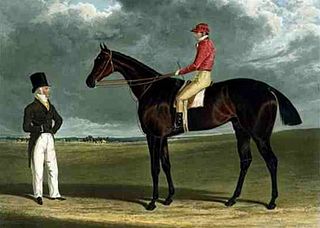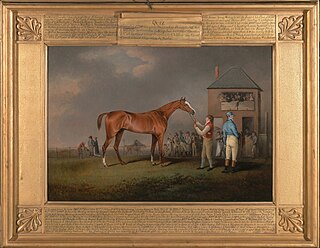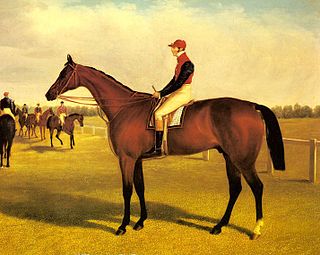
The St Leger Stakes is a Group 1 flat horse race in Great Britain open to three-year-old thoroughbred colts and fillies. It is run at Doncaster over a distance of 1 mile, 6 furlongs and 115 yards, and it is scheduled to take place each year in September.

Newmarket Racecourse is a British Thoroughbred horse racing venue in Newmarket, Suffolk, comprising two individual racecourses: the Rowley Mile and the July Course. Newmarket is often referred to as the headquarters of British horseracing and is home to the largest cluster of training yards in the country and many key horse racing organisations, including Tattersalls, the National Horseracing Museum and the National Stud. Newmarket hosts two of the country's five Classic Races – the 1,000 Guineas and 2,000 Guineas, and numerous other Group races. In total, it hosts 9 of British racing's 36 annual Group 1 races.

Chester Racecourse, also known as the Roodee, is a racecourse located in Chester, England. The horse racing venue is officially recognised by Guinness World Records as the "oldest racecourse still in operation". Horse racing in Chester dates back to the early sixteenth century, with 1539 cited as the year racing began, although some sources give a date of 1512 for the first races in Chester. It is also thought to be the smallest racecourse of significance in England at 1 mile and 1 furlong (1.8 km) long.

Common (1888–1912) was a British Thoroughbred racehorse and sire. In a career that lasted from May to September 1891 he ran five times and won four races. He became the fifth, and the most lighty-raced horse to win the English Triple Crown by winning the 2000 Guineas at Newmarket, the Derby at Epsom and the St Leger at Doncaster.
Herringbone was a British Thoroughbred racehorse and broodmare, best known for winning two Classics in 1943. The filly won four times from ten races in a track career which lasted from spring 1942 until September 1943. As a two-year-old in 1942 she won twice from five starts but was not among the best of her generation. After being beaten on her three-year-old debut she won the 1000 Guineas over one mile at and finished fourth in the Oaks over one and a half miles a month later. In September she beat a field which included the Derby winner Straight Deal to win the St Leger Stakes over one and three quarter miles. All three of the races took place at Newmarket's July Course. After her second classic win she was retired to stud, where she became a successful broodmare.

Black Jester (1911–1928) was a British Thoroughbred racehorse and sire, best known for winning the Classic St Leger Stakes in 1914. The colt won nine times from twenty-three races in a track career which lasted from 1913 until October 1915. Black Jester was one of the leading two-year-olds of 1913 when he won both Molecomb Stakes and the Richmond Stakes at Goodwood. As a three-year-old he finished third in the 2000 Guineas and was unplaced in The Derby before winning the Sussex Stakes at Goodwood and the St Leger at Doncaster in September. In 1915 he won the City and Suburban Handicap and the June Stakes, a wartime substitute for the Coronation Cup. He became increasingly difficult to train and at the end of the season he was retired to stud where he became a successful sire of broodmares.

Jannette (1875–1905), was a British Thoroughbred racehorse and broodmare who won two British Classic Races in 1878. She was one of the leading British two-year-olds of 1877 when she was unbeaten in seven races including the Richmond Stakes at Goodwood. On her first appearance as a three-year-old she was beaten by Pilgrimage in the 1000 Guineas at Newmarket but reversed the form with that filly to win the Oaks at Epsom a month later. Later in the season she defeated some of the season's best colts to win the St. Leger Stakes at Doncaster and added a victory in the Champion Stakes against some of the leading older horses. She was less effective in 1879 but won the Jockey Club Cup on her final appearance. She was then retired to stud, where she had some success.

Orville (1799–1826) was a British Thoroughbred racehorse and sire. In a racing career which lasted from August 1801 until October 1807 the horse ran thirty-four times and won twenty races. In his early career he was based in Yorkshire and won the classic St Leger Stakes at Doncaster Racecourse as a three-year-old in 1802.

Birmingham was a British Thoroughbred racehorse and sire best known for winning the classic St Leger Stakes in 1830. A cheaply bought foal, who almost died before he ever appeared on a racecourse, Birmingham developed into a "celebrated racer" finishing first in twenty-four races from thirty-nine starts between July 1829 and June 1833.

Memnon was a British Thoroughbred racehorse and sire best known for winning the classic St Leger Stakes in 1825. In a racing career which lasted from 1824 until 1828 he ran fifteen times and won nine races. Bred and originally trained in Yorkshire, he was unbeaten in two races as two-year-old in 1824, including the Champagne Stakes and won the York version of the St Leger the following spring. In the St Leger at Doncaster in September 1825, he was successful as the heavily backed favourite in a record field of thirty runners. Memnon was later trained at Newmarket and recorded his most important subsequent victory when winning the Ascot Gold Cup as a five-year-old in 1827. After standing as a breeding stallion for five years in England with moderate results, he was sold and exported to Russia.

Theodore was a British Thoroughbred racehorse and sire best known for winning the classic St Leger Stakes in 1822 at odds of 200/1. Trained in Yorkshire by James Croft, he won the second of his two races as a two-year-old and showed good form the following year, winning races at Catterick, York and Newcastle. His St Leger prospects, however, appeared remote after health problems and poor performances in training gallops. His upset win in the classic, followed by a poor run over the same course and distance two days later, attracted a great deal of comment and suspicions of race-fixing, although none of the allegations was ever proved.

Altisidora (1810–1825) was a British Thoroughbred racehorse and broodmare best known for winning the classic St Leger Stakes in 1813. Bred, trained and raced in Yorkshire she won two of her three races as a two-year-old in 1812. She was unbeaten for the next two seasons, winning three races including the St Leger at Doncaster as a three-year-old and four as a four-year-old in 1814. In her final season she won four of her eight races including a Great Subscription Purse at York, the Fitzwilliam Stakes at Doncaster and a King's Plate at Richmond. She was retired to stud, where she had some impact, being the grand-dam of Ralph, the winner 2000 Guineas and the Ascot Gold Cup. Altisidora died in 1825 at the age of fifteen.

Quiz (1798–1826) was a British Thoroughbred racehorse and sire best known for winning the classic St Leger Stakes in 1801. Quiz was a durable, top-class performer, winning at least once a year in racing career which lasted seven seasons from August 1801 until April 1807. Apart from the St Leger he won many other important races including three Brocket Hall Gold Cups, two Oatlands Stakes at Newmarket Racecourse, a Great Subscription Purse at York, a King's Plate and the Jockey Club Plate. In all he won twenty-one times in thirty-six races for four different owners before being retired to stud, one of which was Mr Hallett Esq, where he proved to be a successful sire of winners.
Cockfighter (1796–1807) was a British Thoroughbred racehorse and sire best known for winning the classic St Leger Stakes in 1799. In a racing career which lasted from May 1799 until August 1802 he won ten of his eighteen races. Originally named Abraham Newland, he was renamed to reflect the sporting interests of Henry Tempest Vane who bought the horse in the summer of his three-year-old season. After bolting on his racecourse debut, Cockfighter was undefeated for more than two years, winning the St Leger, the Doncaster Cup, and three divisions of the Great Subscription Purse at York, and was regarded as the best horse in Northern England. He won the Craven Stakes in 1802, but was retired from racing after a run of defeats later that year. He had little opportunity to establish himself as a breeding stallion, dying in 1807 after four seasons at stud.

The Duchess (1813–1836) was a British Thoroughbred racehorse and broodmare best known for winning the classic St Leger Stakes in 1816. In a racing career which lasted from March 1815 until October 1819 she competed in thirty-three races and won nineteen times. She was still unnamed when winning three races as a two-year-old in 1815, when she was one of the leading juveniles in the north of England. In the following year she was named Duchess of Leven, which was shortened to The Duchess when she was sold to Sir Bellingham Graham. She won seven of her nine races as a three-year-old, including the Gold Cup at Pontefract and the St Leger at Doncaster. The Duchess remained in training for a further three seasons, winning five times in 1817, twice in 1818 and twice in 1819, beating many leading horses of the time including Blacklock, Doctor Syntax, Rhoda and Filho da Puta. After her retirement from racing, The Duchess had some success as a broodmare.

Elis was a British Thoroughbred racehorse and sire best known for winning the classic St Leger Stakes in 1836. In a racing career which lasted from July 1835 until April 1837 he won eleven of his fifteen races. He finished second in his four defeats, two of which came when he was matched against the undefeated Bay Middleton. As a two-year-old he won five of his six races including the Chesterfield Stakes, Molecomb Stakes, Clearwell Stakes and Criterion Stakes. In 1836 he rebounded from a defeat by Bay Middleton in the 2000 Guineas to win Drawing-room Stakes, Racing Stakes, and Lewes Stakes in the summer. Elis was one of the first horses to be transported by horsebox and landed a major betting coup for his owners by winning the St Leger. He had limited impact as a sire of winners before being exported to Germany.

Don John (1835–1857) was a British Thoroughbred racehorse and sire best known for winning the classic St Leger Stakes in 1838. In a racing career which lasted from May 1837 until April 1839 he ran ten times and won nine races, although three of his victories were walkovers when no rival appeared to oppose him. He was one of the leading British two-year-olds of 1837, when his three wins included the Champagne Stakes at Doncaster Racecourse. In the following year he returned to Doncaster where he recorded an emphatic win in the St Leger and then defeated a strong field of older horses in the Doncaster Cup. In the following year he was campaigned at Newmarket where he was beaten for the first time by Grey Momus in the Port Stakes. After one more win he suffered serious leg injuries which ended his racing career. He was retired to stud where he became a successful breeding stallion.
Tehran (1941–1966) was a British Thoroughbred racehorse and sire, who raced during World War II and was best known for winning the classic St Leger in 1944. After showing little ability as a two-year-old he improved in the following spring to win the Culford Stakes on his three-year-old debut. He ran third in the 2000 Guineas and was narrowly beaten into second place in the Derby Stakes. After winning the Whepstead Stakes he recorded his biggest win when defeating a strong field in a substitute St Leger. He won his first three races in 1945 and finished second in the Ascot Gold Cup. He later became a successful breeding stallion, siring several major winners including Tulyar.
Sun Castle was a British Thoroughbred racehorse who raced during World War II and was best known for winning the classic St Leger in 1941. After showing promise as a two-year-old he finished third in the 2000 Guineas the following spring but ran poorly when strongly-fancied for the New Derby. He won a race at Newbury in August before taking the substitute New St Leger at Manchester Racecourse. He died in the following spring after contacting tetanus.
Sandwich was a British Thoroughbred racehorse that won the classic St Leger Stakes at Doncaster Racecourse in 1931, for owner Earl of Rosebery. By 1931, Archibald Primrose, 5th Earl of Rosebery had died, making this a win for his son, Harry Primrose, 6th Earl of Rosebery. Sandwich was a half-brother to Manna, winner of the 1925 Epsom Derby, and as well as his 1931 St Leger success also won the Chester Vase and King Edward VII Stakes.


















